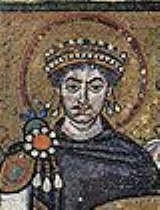
Justinian I
Overview
Justinian I; , ; 483– 13 or 14 November 565), commonly known as Justinian the Great, was Byzantine Emperor from 527 to 565. During his reign, Justinian sought to revive the Empire's greatness and reconquer the lost western half
of the classical Roman Empire.
One of the most important figures of Late Antiquity
and the last Roman Emperor to speak Latin
as a first language, Justinian's rule constitutes a distinct epoch in the history of the Eastern Roman Empire.
Western Roman Empire
The Western Roman Empire was the western half of the Roman Empire after its division by Diocletian in 285; the other half of the Roman Empire was the Eastern Roman Empire, commonly referred to today as the Byzantine Empire....
of the classical Roman Empire.
One of the most important figures of Late Antiquity
Late Antiquity
Late Antiquity is a periodization used by historians to describe the time of transition from Classical Antiquity to the Middle Ages, in both mainland Europe and the Mediterranean world. Precise boundaries for the period are a matter of debate, but noted historian of the period Peter Brown proposed...
and the last Roman Emperor to speak Latin
Latin
Latin is an Italic language originally spoken in Latium and Ancient Rome. It, along with most European languages, is a descendant of the ancient Proto-Indo-European language. Although it is considered a dead language, a number of scholars and members of the Christian clergy speak it fluently, and...
as a first language, Justinian's rule constitutes a distinct epoch in the history of the Eastern Roman Empire.
Unanswered Questions
Discussions
Timeline
527 Byzantine Emperor Justin I names his nephew Justinian I as co-ruler and successor to the throne.
527 Justinian I becomes the sole ruler of the Byzantine Empire.
529 First draft of the ''Corpus Juris Civilis'' (a fundamental work in jurisprudence) is issued by Eastern Roman Emperor Justinian I.
558 In Constantinople, the dome of the Hagia Sophia collapses. Justinian I immediately orders that the dome be rebuilt.

